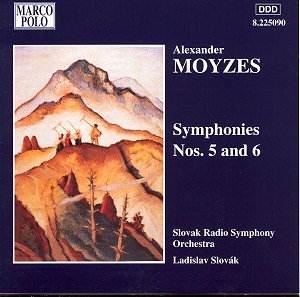Alexander MOYZES (1906-1984)
Symphony No. 5 (1948)
Symphony No. 6 (1951)
Slovak Radio SO/Ladislav Slovák
rec 2-5 Jan 1995, 28 Nov-1 Dec 1994, Concert Hall, Slovak Radio, Bratislava
MARCO POLO 8.225090 [62.06]
Crotchet AmazonUK AmazonUS Amazon recommendations

Moyzes came from a musically sympathetic family and his course to eminence was not obstructed by the usual obstacles. He jostles with Eugen Suchon and Ján Cikker (figures I hope to explore at some stage) as the leading composer of the Slovak generation of the period 1900-1960. His music declares itself firmly rooted in tonal-folk soil. However, rather like Bartók, Moeran, Vaughan Williams and Kodaly, he is no mere window-dresser of folk tunes. His synthesis also takes in the grand Viennese romantic tradition of Schubert and Mahler as well as the central European voices of his teacher, Novák, of Smetana and the 'Hungarian' Brahmsian stream.
Three of the four movements of the Fifth Symphony can, broadly speaking, be placed with Smetana's Festive Symphony, with the folksy elements of Mahler's Symphonies 1 and 4 and with the celebrations of the last movement of Mahler 7. Moyzes is not niggardly in his use of the drums, cymbals and triangle. The second movement has a nostalgia and dream-softened melancholia that does not tear like Shostakovich but is equally telling. Moyzes proves himself a very affecting and inventive voice, taking as his mulch the autumnal reveries of Brahms 3. There are some glorious moments here including the relaxation of the high strings counter-pointing each other. Moyzes found a mood here and sustained it nothing short of brilliantly. The notes are none too specific but there are indications that this work owes something to the Little Mountain Symphony by Alexander's father Mikulas (1872-1944); indeed the symphony was dedicated to the fifth anniversary of Mikulas's death.
The Sixth Symphony is in five movements. It has, in its second, fourth and final movements, the flickering delightful vigour of Roussel's Second, Kodaly's much later symphony, the scherzo of Moeran's G minor symphony and some of the abrasion of Kurt Weill in his two symphonies. There are definite folk inflections, all incisively propelled by the late Ladislav Slovak and his orchestra who presumably know these symphonies better than anyone. Like the other symphony it is most lovingly recorded.
A Moyzes largo or adagio is usually an event, and so it proves in the case of the Sixth; the dream caressingly done with starry-snowy moments like the Rosenkavalier harp-decorated grace of 08.46. This tranced mood links back to the scene setting of the 1.46 Andante tenuto that acts as a prelude to the Allegro leggiero and to the epilogic monologue at the centre of the finale with its shiver and hints of rain and hammerhead clouds.
I must not let slip the opportunity for favourable comment on the Moyzes sleeves which display paintings by Janko Alexy, Martin Benka and Zalo Palugyay. The latter's surrealistic and Munch-like poppies are the prize in this small but select picture gallery. I only wish that Marco Polo would make more room for the pictures.
This is the third issue in the Marco Polo series of the complete Moyzes symphonies - all twelve of them.
Rob Barnett
NOTE
Earlier issues in this series. Each has been reviewed for this site:-
Alexander MOYZES Symphonies 1 and 2 Marco Polo 8.225088 review
Alexander MOYZES Symphonies 3 and 4 Marco Polo 8.225089 review